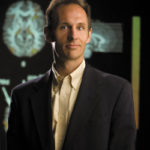 Can the brain re-learn how to use all the functions of a hand transplant?
Can the brain re-learn how to use all the functions of a hand transplant?
Scott Frey, professor of cognitive neuroscience at the University of Missouri, explores this question.
Scott H. Frey is currently the Miller Family Professor of Cognitive Neuroscience at the University of Missouri. Frey received his Ed.M. from Harvard University in Human Development with Howard Gardner, and his Ph.D. in experimental psychology from Cornell University with James Cutting. He subsequently re-specialized in cognitive neuroscience at Dartmouth College and Medical School with Michael Gazzaniga and Scott Grafton.
Frey currently directs the Rehabilitation Neuroscience Laboratory, the purposes of which are to: 1) understand mechanisms underlying the organization and control of manual actions (reaching, grasping, tool and prosthetic use), and 2) use this knowledge to develop evidence-based rehabilitation strategies. A major focus of current work is on determining how mechanisms in the CNS are affected by damage to the PNS, and conversely the role of CNS plasticity in recovery of function. His approach is to seek convergent evidence using a variety of methods (functional and structural MRI, transcranial magnetic and direct current stimulation, electroencephalography, electromyography, and detailed psychophysical and kinematic assessments).
Hand Transplants
When a person loses a hand, nerves that control sensation and movement are severed, depriving sensory and movement areas of the brain of stimulation, causing them to reorganize their functions. In our study, we found that higher-level regions of the brain may compensate for persistent reorganizational changes in brain areas responsible for hand sensation and movement.
Currently, there are approximately 75 former amputees worldwide who have received hand transplants. While conceptually similar to heart, lung and kidney transplants, hand transplants present unique challenges. For successful recovery, the brain that has reorganized following hand loss must relearn how to feel with, and control voluntary movements of, the new hand.
We studied a trauma victim who had lost his left, non-dominant hand through a crush injury at the age of 23. He underwent the transplant procedure over a decade later and essentially had to “re-learn” sensory perception and basic motions, such as reaching and grasping.
The patient completed a series of ordinary reaching and grasping tasks at different intervals following the hand transplant procedure. Regions of the brain were monitored by functional magnetic resonance imaging (fMRI) to observe how the brain reacted to the tasks. We found that at 26 and 41 months post-surgery, the patient showed marked improvements in hand function that were accompanied by some surprising adaptations in the brain.
While areas involved in basic sensory and motor functions exhibited persistent amputation-related changes, higher-level regions that typically control reaching and grasping actually took over their old functions again.
Results suggest that even in the middle-aged brain, when stimulation is provided, areas of the brain that are “upstream” may compensate for persistent reorganizational changes in “down-stream regions.”
This fresh perspective, if correct, may have broad implications for how approach the challenge of neurorehabilitation in a variety of conditions including the rehabilitation of amputees and stroke patients.